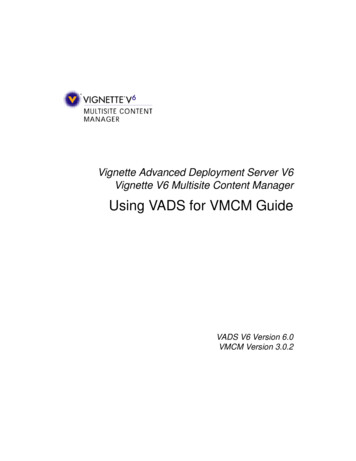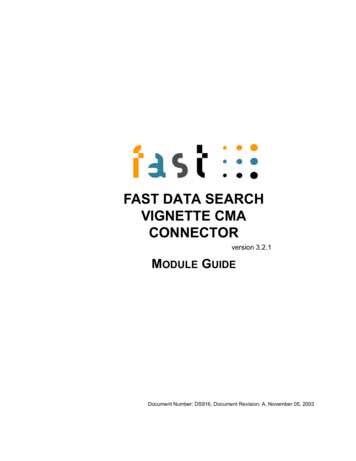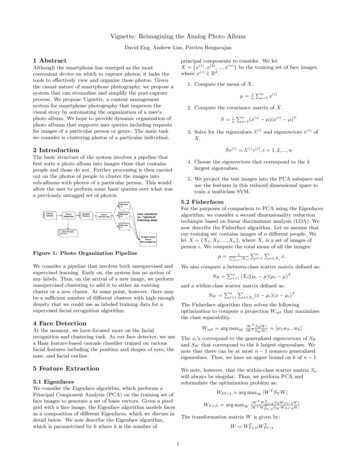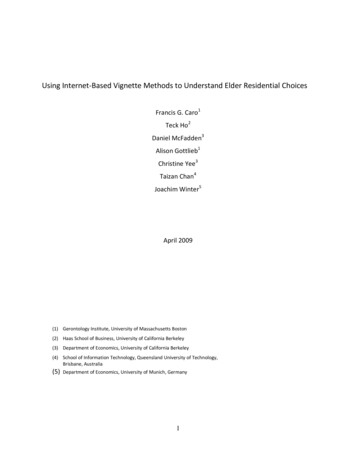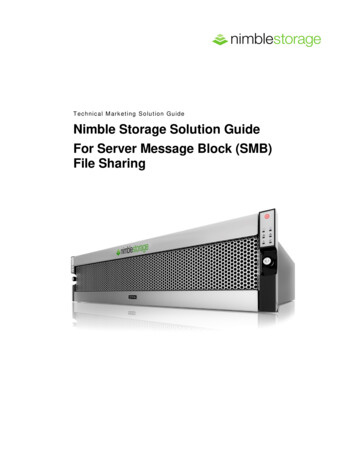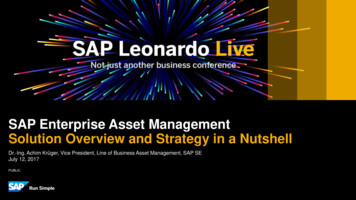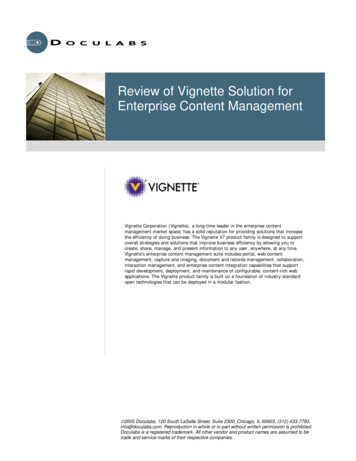
Transcription
Review of Vignette Solution forEnterprise Content ManagementVignette Corporation (Vignette), a long-time leader in the enterprise contentmanagement market space, has a solid reputation for providing solutions that increasethe efficiency of doing business. The Vignette V7 product family is designed to supportoverall strategies and solutions that improve business efficiency by allowing you tocreate, share, manage, and present information to any user, anywhere, at any time.Vignette’s enterprise content management suite includes portal, web contentmanagement, capture and imaging, document and records management, collaboration,interaction management, and enterprise content integration capabilities that supportrapid development, deployment, and maintenance of configurable, content-rich webapplications. The Vignette product family is built on a foundation of industry-standardopen technologies that can be deployed in a modular fashion. 2005 Doculabs, 120 South LaSalle Street, Suite 2300, Chicago, IL 60603, (312) 433-7793,info@doculabs.com. Reproduction in whole or in part without written permission is prohibited.Doculabs is a registered trademark. All other vendor and product names are assumed to betrade and service marks of their respective companies.
2Doculabs Review of Vignette V7What’s InsideVignette at a GlanceProvides a snapshot of the Vignette organizationThe Case for Enterprise Content ManagementDescribes the major challenges that businesses and their IT organizationsface for storing, managing, and maintaining structured and unstructuredcontentVignette’s Approach to Enterprise Content ManagementProvides an overview of Vignette’s vision and Doculabs’ assessment of whatsets the Vignette solution apart in the ECM marketSolution ReviewProvides an overview of Vignette V7, including its functional componentsand architectureBusiness BenefitsHighlights the business benefits of the Vignette product, including improvedefficiencies, reduced support costs, and architectural extensibilityFinal WordProvides Doculabs’ overall assessment of Vignette V7 and its valueproposition, as well as a review of its strengths and opportunities forimprovement
Doculabs Review of Vignette V73Vignette at a GlanceVignette CorporationAustin, TX 78746888.608.9900www.vignette.comYear Founded1995Stock SymbolNASDAQ: VIGNLast Year’s Revenue 177.9 millionCustomersVignette does business with 52% of Fortune 100companies, and provides commercial product technologyfor 15 of the 50 largest internet sites and 6 of the top 10sites (source: JupiterResearch). Vignette has more than1,700 customers across all major industries.Employees730 (2004)Office LocationsCorporate headquarters in Austin, Texas; regional officesthroughout the U.S., Latin America, Europe, and AsiaPacific
4Doculabs Review of Vignette V7The Case for Enterprise Content ManagementOrganizations are more concerned with managing their content than everbefore. More than 80 percent of the information in the average organizationis “unstructured” information, such as office documents, paper documents,images, graphics, multi-media files, computer-generated reports, e-mail, andweb content. Given the explosion of this unstructured information,organizations need strategies and solutions to help them control and leveragethis information as an asset, deliver it in context to various constituencies,manage its risk as a liability, and reduce the costs of keeping it.As defined by the Association for Information and Image Management(AIIM), enterprise content management (ECM) consists of “the technologiesand tools used to capture, manage, store, preserve and deliver content acrossthe enterprise.” This definition is fairly high level. A better way to thinkabout content management is that it: Manages multiple types of content, including unstructured content suchas file-based Microsoft Office documents; semi-structured dynamiccontent types such as web content; fixed content types such as images, email, and computer-generated output; and structured content such asdatabases Manages this content throughout its lifecycle stages, from creation andcapture, to management and archival, and to retrieval and delivery Encompasses process management and integration to put the content towork, in the context of existing business processes and technologyenvironmentsWhile there are many reasons why organizations invest in ECM and relatedtechnologies, all of these drivers can essentially be categorized into one ofthree areas: offense, defense, and IT.Organizations that are driven by “offense” strategies seek to use ECM toimprove the business in some meaningful way. This includes reducingoperational costs and improving efficiency and productivity. It can alsoinclude improving customer service and satisfaction, providing personalizedcommunication, enabling self-service and improving customer acquisitionand retention. Finally, “offense” includes growing the business.Organizations use ECM to improve operational efficiency and facilitategrowth by digitizing content and automating manual processes.Organizations driven by “defense” strategies are seeking to use ECM toprotect the organization and mitigate risk. This includes addressingregulatory compliance and litigation (and their costs), as well as businesscontinuity and security. The importance of this “defensive” driver hasescalated in recent years, as fixed content has come under increased scrutinyas a result of existing and emerging regulatory requirements, compliancemandates, and stringent records management demands in the wake ofcorporate accounting scandals.
Doculabs Review of Vignette V75Finally, organizations for which IT is a significant driver seek to deploy andsupport appropriate technologies to fulfill the organization’s offensive anddefensive requirements and enable future strategic business initiatives.Organizations need to ensure the effectiveness and efficiency of their IToperations, and thus require systems that are straightforward, work well inexisting environments, and provide clear value for the cost incurred.Organizations also require solutions that deploy quickly and require minimaladministrator and user training. Such IT drivers are critical for mid-marketorganizations with limited IT resources.In the past few years, the market has seen an increase in drivers in all threeareas. For example, the recent economic downturn forced organizations tolook at their operational efficiencies and find ways to eliminate redundantinformation and enhance support for business processes. New regulationshave led to an increased emphasis on risk reduction and recordsmanagement, and deliberate attacks on business and natural disasters haveelevated the importance of business continuity and disaster recovery. Finally,IT organizations continue to evolve their strategies to optimize theirenvironments and leverage existing technology investments.
6Doculabs Review of Vignette V7Vignette’s Approach to Enterprise ContentManagementVignette Corporation (Vignette), a long-time leader in the enterprise contentmanagement market space, has a solid reputation for providing solutions thatincrease the efficiency of doing business. The company currently has morethan 1,700 customers that span a wide range of industries, including financialservices, manufacturing, high tech, media and entertainment, and the publicsector and education.The Vignette V7 product family is designed to support overall strategies andsolutions that improve business efficiency by allowing you to create, share,manage, and present information to any user, anywhere, at any time.Vignette’s enterprise content management suite includes, portal, web contentmanagement, capture and imaging, document and records management,collaboration, interaction management, and enterprise content integrationcapabilities that support rapid development, deployment, and maintenance ofconfigurable, content-rich web applications. The Vignette product family isbuilt on a foundation of industry-standard, open technologies that can bedeployed in a modular fashion.Enterprise Content Management, the Vignette ECM platform thatencompasses the six products listed in the table below, provides capabilitiesto control, manage, and share information, optimize business processes,integrate with enterprise applications, eliminate redundancy, and mitigaterisk for compliance.ProductDescriptionVignette ContentManagementWeb Content Management allows users to access andmanage all types of content created by a variety of authors,and to publish the content to the right user at the right timethrough a variety of channels.Vignette Records &DocumentsDocument and Records Management provides capabilities tocapture, store, process, and manage virtually all types ofinformation; automates repetitive processing, reducing riskand brings silos of documentation under control whileproviding comprehensive records management capabilities.Vignette PortalPortals provide secure and personalized online access to alltypes of services, applications, and content drawn frommultiple sources within an organizationVignetteCollaborationCollaboration provides capabilities to facilitatecommunications among colleagues, customers, prospects,and partners to securely share knowledge, information, anddocumentsVignette BusinessIntegration StudioEnterprise content integration integrates structured andunstructured content from disparate sources and applicationsthrough pre-packaged integration modules and technologyadaptersVignette DialogExtends the immediate interaction model of the web andprovides for long term dialogs with measurement andauditing, improving relationships and customer loyalty, andenforcing compliance requirements
Doculabs Review of Vignette V77The following subsections discuss the differentiating capabilities thatVignette V7 provides as an enterprise content management solution.Breadth and Depth of ECM CapabilitiesThe Vignette V7 platform offers a complete solution set for authoring,management, integration, analysis, and delivery of information under acommon architecture and user interface.In addition to offering comprehensive, deep ECM capabilities, Vignetteoffers several products whose potential are only now beginning to be realizedby the user community. These include Vignette Business Integration Studiofor enterprise content integration, Vignette WebCapture for creating recordsof web transactions, and Vignette Collaboration. Vignette BusinessIntegration Studio allows organizations to quickly and easily integratestructured and unstructured content from disparate sources and applications.Such remote, virtual, or federated repository management is beginning to bea hot area in ECM today, but Vignette has been doing it for years.Vignette’s WebCapture is designed to efficiently capture, manage, andprovide records management functionality to the sequence of events oractions that a user performs while visiting a web site. Very few vendors offerthis type of capability, and organizations are now beginning to recognize it asrequired functionality for risk mitigation.Finally, Vignette’s collaboration capabilities provide a welcome alternativeto the inexpensive but superficial collaboration provided by the infrastructurevendors, and the more robust but resource-intensive capabilities provided bysome of the other ECM vendors.Comprehensive Open Approach Provides FlexibilityVignette V7 was implemented from the ground up using standards-basedJ2EE and XML technologies. Vignette V7 was developed as a true J2EEapplication, using the core server-side J2EE specifications and APIs such asEJB, JMS, JMX, JAAS, JTS, Servlets, and JSP, as well as a host of XMLbased specifications and frameworks. This approach enables the product toutilize the functions and services of application servers, such as clustering,load balancing, performance, and security, thus speeding applicationdevelopment and helping organizations avoid the effort and expense ofcreating crucial services on their own.Flexible Packaging to Address Today’s DemandsVignette’s approach to packaging the Vignette V7 solution is very flexibleand greatly facilitates the adoption of the product for new or “green-field”customers – as well as meeting the deployment requirements for the rapidlygrowing population of which require a modular system that can fit into anexisting ECM “ecosystem.”
8Doculabs Review of Vignette V7At the highest level, Vignette offers Content Management, Portal, Documentand Records Management, Imaging, and Collaboration solutions, as well asAnalytics, Integration, and Process services. Each of these can exist as astandalone component in an overall ECM solution. For example, a companymight use Vignette Content Management for the core content in a system, butpresent some of the content via a different packaged portal or a“homegrown” solution.The vision of a common architecture for the product suite is at the base of thestrategy. Without a modular, standards-based architecture, it would bedifficult to add and remove components from a componentized solutionwithout rewrites across the different permutations of product configurations.To assemble the core offerings, Vignette has a suite of modular solutions thattogether comprise the Vignette Enterprise Content Management Suite. Thisprovides a very flexible choice for organizations that may not want to jumpinto the entire offering all at once, but rather build as they go. For example,an organization may have a homegrown content management system that itwould like to present using a portal framework. Using Vignette Portal, it cando this. Later, when its content grows to a level that requires a more robustmanagement system, the organization can add on Vignette ContentManagement and leverage the core process services, knowing that these willintegrate with each other, as well as with the portal.Total Cost of OwnershipWhen one looks at the overall costs associated with managing enterprisecontent, Vignette V7 makes good economic sense. First of all, the fact thatVignette V7 is an open standards-based system means that any currentinvestment in web application servers, such as WebLogic or WebSphere, canbe leveraged. Vignette can coexist with other applications on the applicationserver without issue as long as they are tuned correctly. Repositoryintegration is a significant factor as well. With its virtual repository strategy,Vignette can use as its content any current content repository, leveragingcurrent operating content definitions. This can be a permanent, ongoingusage, or as a transition period while newer content is developed usingVignette Content Management.
Doculabs Review of Vignette V79Solution ReviewThis section presents Doculabs’ assessment of Vignette V7, includingdiscussions of its differentiating functional components, its architecture, andits administrative capabilities.The Modular Components of Vignette V7Following are brief overviews of the modular components of Vignette V7,focusing on areas where Vignette has recently enhanced the product.Vignette V7 PlatformVignette has been a major player in the content management market formany years, and the platform has evolved to become a remarkablycomprehensive J2EE-based solution; full integration is an objective thatmany other ECM vendors are still striving to accomplish. This approach hasmany benefits, including vast scalability, providing a multi-tiered distributedapplication model, the ability to reuse components, an integrated and openXML-based data interchange, and a unified security model.The base platform provides the core content management capabilities “underthe hood,” and Vignette defines these as: Content Management – Vignette’s information hub that defines,collects, and organizes content Portal – a portal framework used to unite the content applications andpresent them through a flexible web-based interface Integration – a content integration mechanism that provides the primarymechanism to transfer and transform content between sources anddelivery channels Process – a “traffic manager” that routes content through systems andapplies business rules Analysis – a detailed logging and reporting tool of content usage andactivity Collaboration – an application for managing interactions andcommunication between users and the sharing and exchange of contentand discussion Documents and Records Management – a strong imaging, archival andstorage retention management application Interaction Management – an application for managing proactivedialogs, based on personalized interactions through integrated, automatedbusiness processes Imaging – an application to capture, store and process high-volumeimages for efficient electronic access
10Doculabs Review of Vignette V7The modular components of Vignette V7 integrate with the base platformand can be procured individually, based on organizational or departmentalrequirements. The modular components include: Vignette Content ManagementVignette PortalVignette Records & DocumentsVignette CollaborationVignette Business Integration StudioVignette DialogThe following subsections discuss each of these components in detail.Vignette Content ManagementOne of the strengths of a robust ECM solution is its ability to allow re-use ofcontent across multiple channels. Delivering content to the web – whether inthe traditional sense, such as customer self-service external web sites, or foruse internally in an intranet or partner extranet – is an essential requirementin today’s publishing environment. A key strength of the Vignette solution isits ability to provide web content management (WCM), a capability thatextends back to Vignette’s roots as a WCM vendor and today is a fineexample of an easy-to-use, full-featured web content management solution.Vignette’s WCM capabilities are similar to those offered by its competitors,with a few notable exceptions. First, Vignette Content Management is fullyintegrated with the Vignette V7 platform, allowing content created orcaptured in any other Vignette application to be easily reused on a web siteor intranet. Many ECM vendors today, including the larger ECM vendors,are still struggling with the full integration of their WCM solutions with therest of their platforms. In some cases, this is due to the vendor’s heritage;those that began in the imaging or document management industries havehad to “bolt on” WCM solutions to meet market demands. Vignette’s originwas in WCM; thus it is no surprise that its product excels in this arena.Vignette Content Management met or exceeded our expectations in thefollowing ways: Dynamic Delivery – Content such as electronic documents, web content,and even structured data can be ingested, stored, and reused for deliveryto a web site and other channels. Content can be created within theVignette application itself, extracted from a structured or unstructuredcontent source, retrieved from the web, or authored in a desktopapplication or other program. Content can be then transformed anddelivered to a variety of formats (PDF, images, HTML) or presentedthrough a specific channel (web, print, or inserted into a databasedestination).
Doculabs Review of Vignette V711 User Experience – Vignette provides a polished user interface (UI) andhas paid attention to the details. Doculabs believes that the quality,simplicity, and consistency of a solution’s UI translates directly into thelevel of user adoption that results after deployment. The Vignette userinterface is best of breed, including floating editing palettes that alwaysremain within reach of the user’s mouse pointer (as opposed to beingplaced at the top or bottom of an editing page, requiring a user torepeatedly scroll up or down to reach a menu bar when editing longpages of content). Editing Tools – Vignette Content Management can provide in-contextediting – the ability to edit a web site or intranet page just as one wouldsee it if going to the real site. The cont
Enterprise Content Management Vignette Corporation (Vignette), a long-time leader in the enterprise content management market space, has a solid reputation for providing solutions that increase the efficiency of doing busine
